Owning a second-hand hybrid or electric vehicle in the Netherlands can seem like a daunting task.
Why? Well, you first need to figure out where to start looking before you buy one.
Then, once you own one, there are a couple of things to consider, such as:
- charging your electric vehicle,
- driving range of your electric vehicle,
- taking care of your electric vehicle’s battery,
- subsidies and road tax (BPM),
- and Dutch car insurance.
Sounds like a lot? Don’t worry. We’ll walk you through it step by step. 👇
Types of electric vehicles in the Netherlands
There are three main types of electric vehicles you’ll see on the market: battery electric vehicles (BEVs), hybrid electric vehicles (HEVs), and plug-in hybrid electric vehicles (PHEVs).
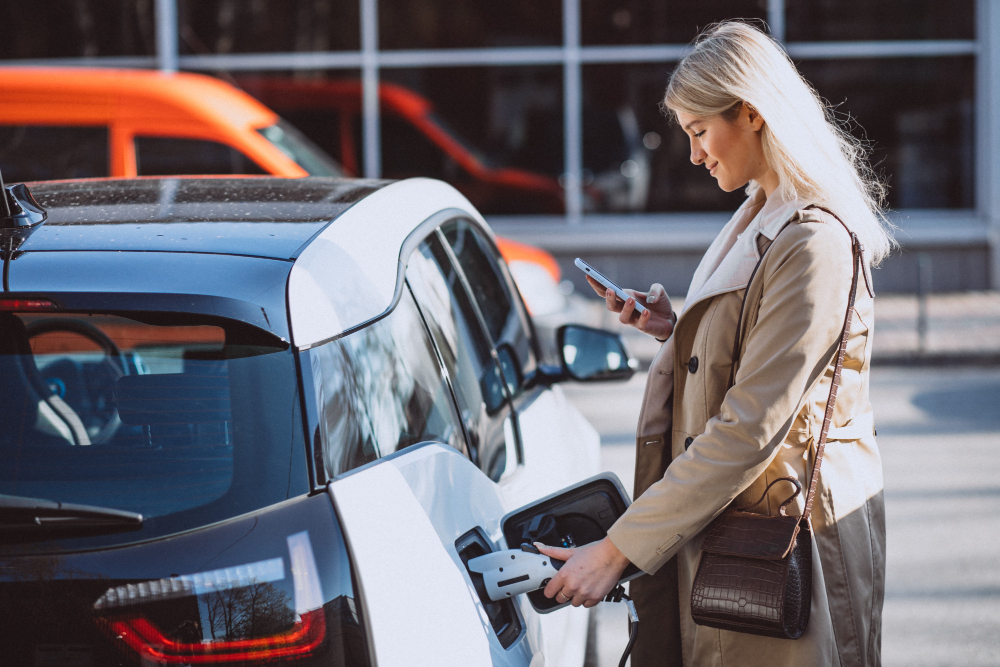
All of these types of electric vehicles are available in the Netherlands. However, it’s important to know which type of electric vehicle you want. The type of hybrid or electric vehicle affects certain costs like vehicle subsidies and road tax.
Battery electric vehicles (BEVs)
BEVs are the traditional electric vehicles — they usually don’t have an internal combustion engine (ICE), fuel tank, or exhaust pipe.
These vehicles are entirely powered by electricity and are generally better for the environment (and the bank account). BEVs have to be plugged in to recharge.
Hybrid electric vehicles (HEVs)
HEVs were the first type of electric vehicle in the industry, with both an ICE and electric motors. Often, a HEV will use electricity for city driving and the ICE for highway driving.
HEVs are the true hybrid vehicles. The batteries replenish themselves with the energy generated by the internal combustion engine and the vehicle, therefore, doesn’t have to be charged.
Plug-in hybrid electric vehicles (PHEVs)
PHEVs are also hybrid electric vehicles that run on both gasoline and electricity. But as the name suggests, they have to be plugged in to recharge. 🔌
This is the main difference compared to HEVs.
Typically these vehicles have the option to run on just electricity, as well as just fuel, or a combination of both.
Charging your second-hand electric vehicle in the Netherlands
If you own (or plan to own) a second-hand electric vehicle, it’s important to know your recharging options in the Netherlands. 🔋
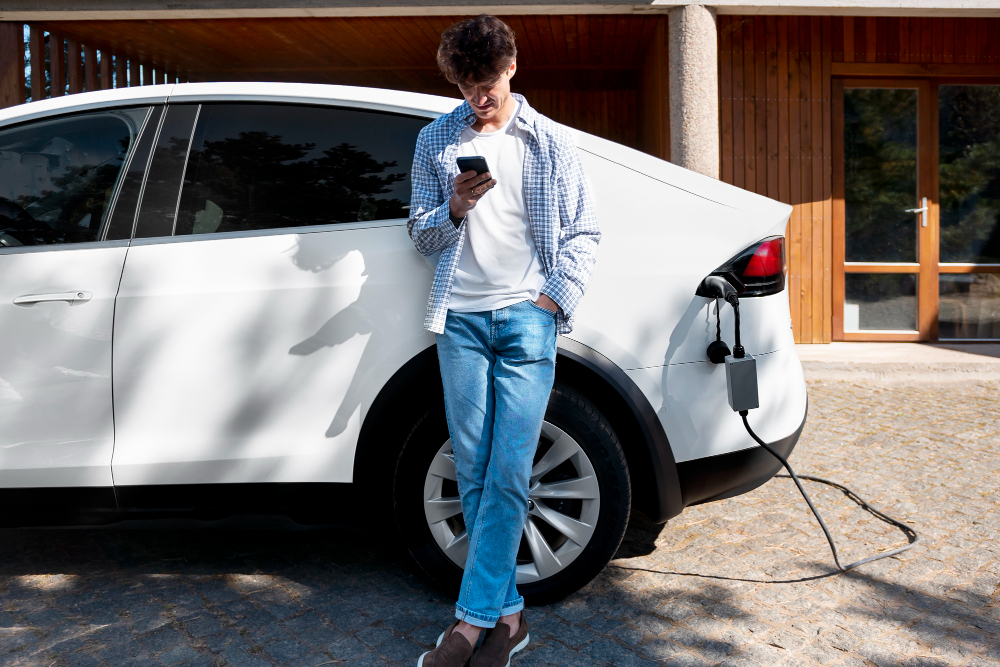
Charging at home
Many people opt to charge their second-hand electric vehicles at home — and for good reason! Charging at home means your car has a designated spot to charge and has enough time to completely replenish its battery.
To be able to charge your electric car at home, you’ll, of course, need some space — whether that’s in a garage or at a personal parking spot.
Types of home chargers
There are two main types of home charging stations: level 1 charging and level 2 charging. Level 1 involves charging your electric vehicle with the charger that comes with the vehicle.
These chargers can be plugged into any standard wall outlet with the other end plugged directly into the car — and they typically charge 200 kilometres within 20 hours.
Level 2 chargers are sold separately from the vehicle. These chargers require a more complicated setup as they’re usually wired directly into your house’s electrical system.
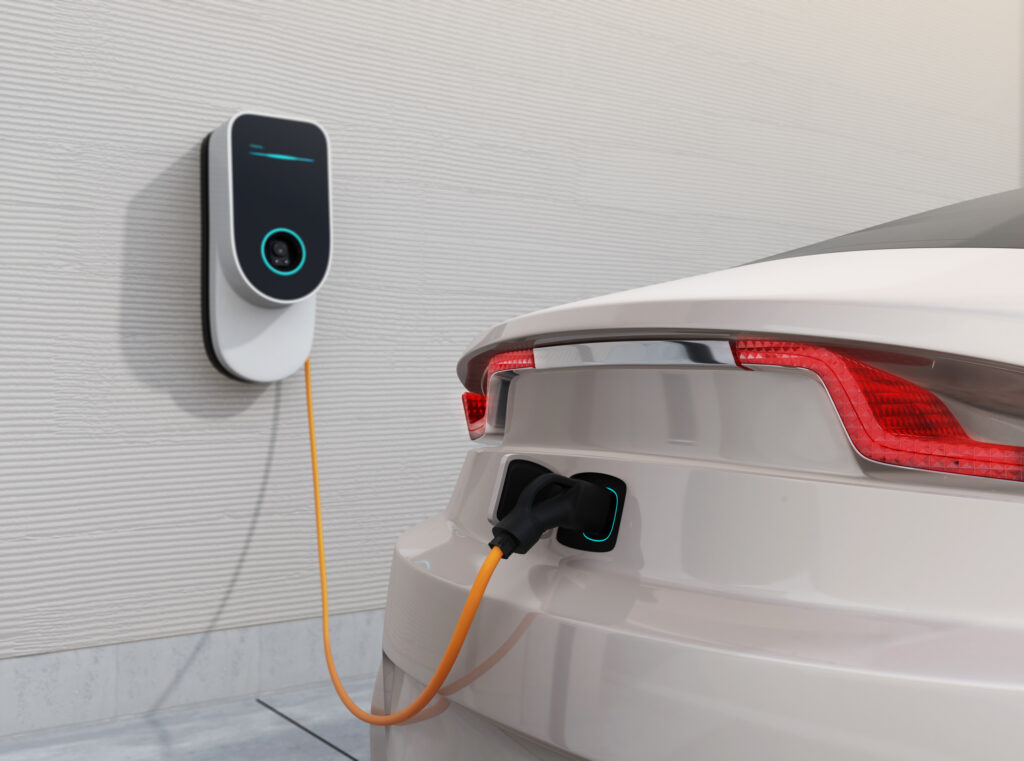
Depending on your charger, they can charge your car between three and seven times faster than the charger that comes with your car.
How much does home charging cost in the Netherlands?
With level 1 home charging stations, costs include the purchase of the car itself. Level 2 chargers (depending on the model and voltage) can be anywhere between €900 to €4,000, including installation costs.
To charge your car, the average kilowatt per hour (kWh) costs are €0.30 to €0.45. Each car has its own criteria for how many kWh it needs to drive a certain distance, so it’s best to check how many kWh is a full charge for your car and how far it drives with a full battery.
Charging electric vehicles on the street in the Netherlands
In all large Dutch cities and towns, the municipalities have set up designated parking spaces and charging stations for electric vehicles.
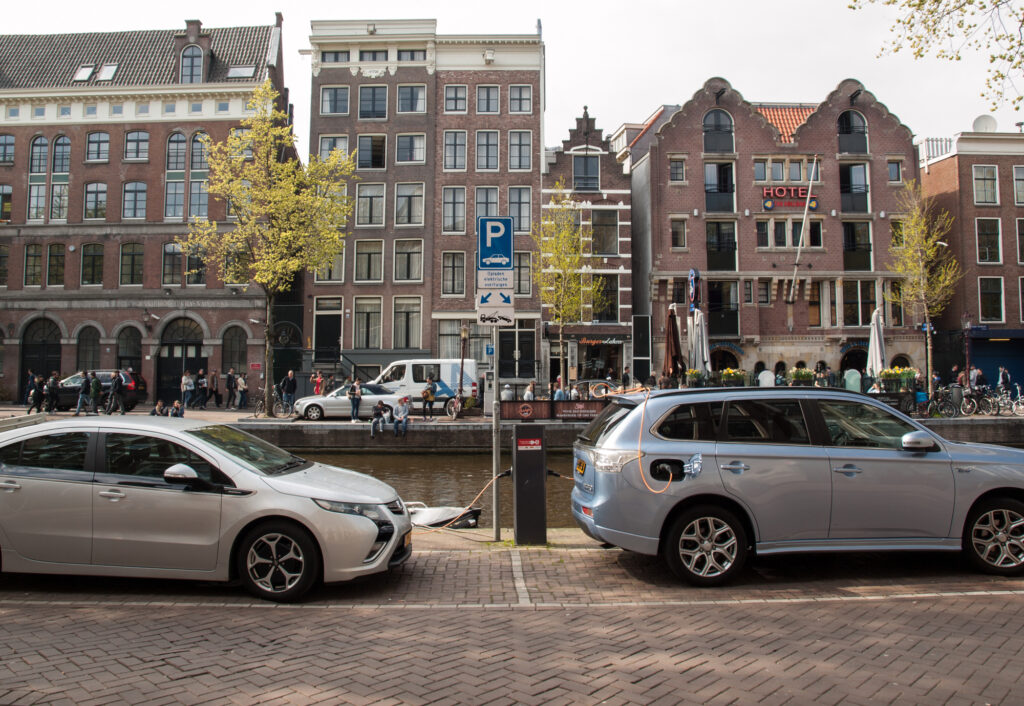
If you park in an electric vehicle parking space, your car must be connected to a charging station. There’s usually no time limit on charging, but if you’re charging in a neighbourhood, it’s best to consult with your neighbours to establish some parking and charging etiquette.
Tip: If you’re charging your second-hand electric vehicle in a Dutch city, it counts as free parking! Although available charging spots are a little difficult to find in the city, as long as your car is charging, you park for free.
Charging passes
The good news is that, if necessary, electric vehicles in the Netherlands get priority on parking permits. However, to access charging stations, you will also need a charging pass. You can request both the pass and the permit from your municipality.
Once you’ve received them, you can use the charging pass to scan the charging point, which will then supply electricity for your car.
On average, you can expect to pay about the same amount per kWh on the street as you would at home — between €0.30 and €0.35.
The range of your second-hand electric vehicle
Electric vehicle drivers often have range anxiety — the fear that their battery will die mid-trip. Of course, this may be even more of a concern when purchasing a second-hand electric vehicle.
Not to worry though! Second-hand electric vehicles will most likely only show minor signs of battery degradation. In other words, the car battery is only a little worn out compared to a completely new one.

The condition of your second-hand electric vehicle’s battery depends on a few things, like the age of the car, previous and current usage (long vs. short drives, frequency, highway vs. city driving), and overall battery life.
On average, electric vehicles have a range of about 315 kilometres, which should be more than enough to find a charging station (especially if you’re driving within the Netherlands). Depending on your car model, the range can be from 270 kilometres all the way up to 615 kilometres per charging cycle.
Taking care of your Dutch second-hand electric vehicle
Of course, once you own a second-hand electric vehicle, there are a few things to keep in mind when you do maintenance.
How does second-hand EV maintenance work in the Netherlands?
Maintaining a second-hand EV is similar to maintaining a regular internal combustion engine (ICE) vehicle. Every so often, you should take your vehicle to your local car repair and maintenance shop.
You can get everything checked up to make sure the car is up to par — the tires, braking system, motors, you name it.
Most repair and maintenance shops offer services for electric vehicles, so things like battery check-ups and replacements, as well as charging system maintenance, are easily accessible.
READ MORE | 7 things to know before owning a car in the Netherlands
Maintenance and check-up costs vary depending on your auto shop and the extent of your maintenance.
Kleine beurt versus grote beurt: what’s the difference?
When you get around to maintaining your electric vehicle, you might come across the terms kleine beurt and grote beurt. But what do they mean?
Essentially, a kleine beurt refers to a minor service, and a grote beurt refers to a major service on your car. Minor services are cheaper and entail general maintenance on your car, while major services involve more intense inspection and replacements.
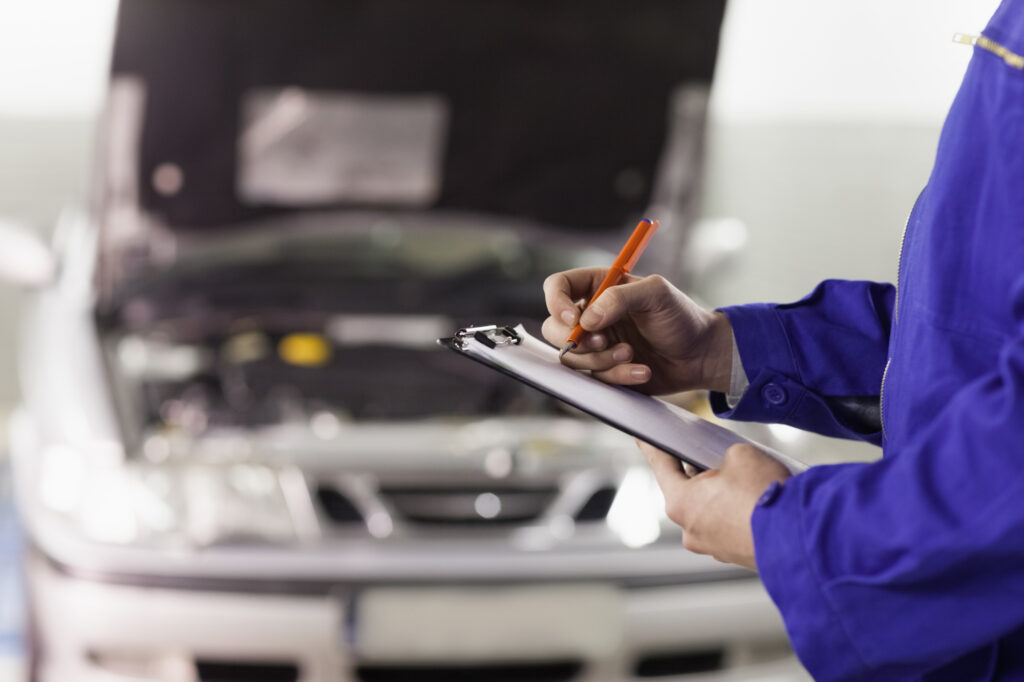
Mechanics usually advise drivers to bring their car in for a service as follows:
- Every 15,000 kilometres driven requires a minor service. Even if you haven’t driven 15,000 kilometres though, mechanics recommend your second-hand car gets a minor service every year.
- Every 30,000 kilometres driven requires a major service. If you haven’t driven 30,000 kilometres (but have driven more than 15,000 kilometres), a major service on your car is recommended every two years.
Minor services cost between €100 and €150 on average, depending on your usual car repair shop. However, the price can be a bit higher depending on what parts of your car need replacing and maintenance.
Major services are (obviously) a lot pricier. The cost of a major service typically falls between €200 and €400, also depending on your car repair shop and which parts you need to replace and maintain.
Sometimes, it’s possible to combine the APK (the general yearly inspection your car goes through) with a major service on your car which would total between €700 and €1,000.
Car insurance in the Netherlands
To be prepared for the worst, it’s important to have insurance on your hybrid or electric vehicle. In fact, car insurance is compulsory in the Netherlands, and you’re required to have it to legally drive here.
The nice thing about Dutch car insurance is that it insures the car, not the person. This means that, as long as they have your permission, anybody can legally drive your car.
There are three types of car insurance policies that you can choose from:
- Third-party liability (WA verzekering)
- Extended liability (WA beperkt casco)
- All-risk insurance (Allriskverzekering)
There are plenty of companies that offer car insurance for every occasion, such as Univé. We recommend you do some research and find one that fits your wants and needs.
Roadside assistance (wegenwacht) in the Netherlands
While we all hope this will never happen to us, there’s always the chance of running into car trouble while on the road. Whether it’s a flat tire or broken lights, you can easily access roadside assistance (also known as Wegenwacht in Dutch) in the Netherlands.
ANWB is the most common roadside assistance provider in the country and they even offer membership plans that provide roadside assistance throughout Europe! (Definitely useful if you plan to take road trips often).
If you’re thinking of getting a subscription for roadside assistance in the Netherlands, there are two types of subscriptions specifically for hybrid and electric vehicles:
| Standard | Complete | ||
| Per month | €14.30 | €18.95 |
All subscriptions include towing and repair services if you happen to run into car trouble while travelling.

The ANWB also has a specific procedure in case they get a call for a hybrid or electric vehicle that needs assistance. In any case, you can be sure your hybrid or electric vehicle is in good hands if it ever breaks down.
Subsidies for owning a second-hand electric vehicle in the Netherlands
The Netherlands made more than just a few targets for sustainability in the last year. Making transport more climate-friendly is also part of that.
If you buy a hybrid or electric vehicle (whether it’s new or second-hand), you might be eligible for some subsidies from the Dutch government!
The Dutch electric car purchase subsidy (SEPP)
Subsidieregeling Elektrische Personenauto’s Particulieren (SEPP) or Electric Car Purchase Subsidy refers to a financial scheme for those who purchase an electric car.
However, there are a few requirements you have to meet for this subsidy in general:
- You own a 100% electric passenger car with a range of at least 120 kilometres (so no hybrid cars in this case).
- The listing price of the car as registered at the Dutch Vehicle Authority (RDW) is between €12,000 and €45,000.
- The car was produced as an electric passenger car and was not converted into an electric car.
In 2022, you can get €2,000 for a used electric passenger car on sale or on private lease and €3,350 for a new electric passenger car.
Keep in mind though that there are additional requirements you have to meet depending on whether you’re buying or leasing or have a used or new electric car (information available in Dutch).
Exemption from motor vehicle tax (MRB) and private vehicle and motorcycle tax (BPM)
Both fully electric and hybrid cars can get some tax exemptions when it comes to motor vehicle tax (MRB) and private vehicle and motorcycle tax (BPM).
Not sure what the difference between the MRB and BPM is? We got you. MRB refers to the general road tax you have to pay when you own a vehicle. BPM, on the other hand, refers to the tax you pay when you own a private vehicle, whether that’s a motorcycle, car, or van.
Fully electric cars get a complete exemption from paying the motor vehicle tax (MRB). Hybrid electric cars that emit less than 50 grams of CO2 per kilometre pay half the tax rate.
Fully electric cars also get an exemption from paying private vehicle and motor tax (BPM). However, this is not the case for hybrid electric cars.
Environmental investment allowance (MIA)
Entrepreneurs and businesses in the Netherlands also get special incentives to buy electric cars for their companies.
Anyone who is investing in environmentally-friendly techniques can also get extra tax benefits. New, fully electric cars are eligible for an environmental investment deduction (Milieu-investeringsaftrek) of up to 27% of the total cost (up to €40,000)!
What does this mean? You could be entitled to €5,000 for owning a new, fully electric car! However, the car also has to be less than 6 months old or with less than 6,000 kilometres driven on it.
While there are a lot of things you’ll have to keep in mind when owning a second-hand hybrid or electric car, there are a lot of perks that come with it too!
Once you’ve considered and sorted all of these factors, you’re more than ready to own an awesome second-hand electric vehicle. Happy driving!
Are you considering owning a second-hand electric vehicle in the Netherlands? What are your tips for owning and maintaining an electric vehicle? Tell us in the comments!
Tip: If you’re charging your second-hand electric vehicle in a Dutch city, it counts as free parking! Although available charging spots are a little difficult to find in the city, as long as your car is charging, you park for free.
Except on Amsterdam? I got a fine there following this advice.